
The boat docked and we landed once again in Positano. We wandered around
the waterfront, then headed "uptown" on the steep, narrow streets.
All too neat — the shops, cafes and homes — tightly bunched
and artfully stepped up the hill. A lot of pastel colors and stuccos,
and a Moorish influence in many of the small structures. Positano managed
to retain its quaintness and unique appeal despite the heavy tourist traffic.
[Positano
panoramic]
 Though
I still wanted to shop, I was really dragging under the weight of Capri
stuff, cameras, etc. on tired feet. Let me try to explain this because
I'm really not the shopaholic I might appear to be: I didn't want to necessarily
acquire more stuff, just more information. That meant books, maps, postcards
et al. I never (well, rarely) feel sated after visiting a special place.
So I have to gather what I can of it to revisit afterwards (and lament
what I missed seeing/doing). This is mostly for me, though I really like
to share this with anyone who is interested. Hence, I suppose, the motivation
for all the photos, this page, this web site.
Though
I still wanted to shop, I was really dragging under the weight of Capri
stuff, cameras, etc. on tired feet. Let me try to explain this because
I'm really not the shopaholic I might appear to be: I didn't want to necessarily
acquire more stuff, just more information. That meant books, maps, postcards
et al. I never (well, rarely) feel sated after visiting a special place.
So I have to gather what I can of it to revisit afterwards (and lament
what I missed seeing/doing). This is mostly for me, though I really like
to share this with anyone who is interested. Hence, I suppose, the motivation
for all the photos, this page, this web site.
Low fog/clouds shrouded the peaks above Positano; as the late-day light filtered through, the town had a eerie look. [More coastal views]
Now, it was time to get back to Praiano ... simple, we were told: just catch one of the local busses that run regularly around the peninsula. Well, maybe they do in the morning. We ended up having a long wait, but were entertained by some near collisions at the hairpin turn (picture below) next to the bus stop. Craig & Linda, our Australian friends, were waiting also and we passed the time with them.
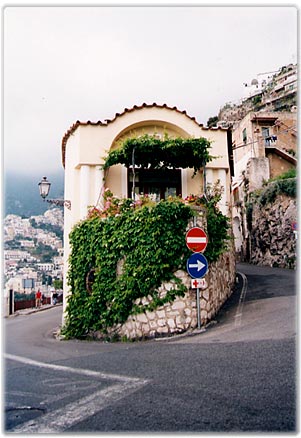
|
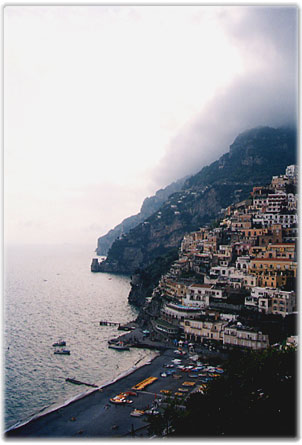
|
The next day was a
day of rest, sort of. We sat on the terrace outside our room above the
sea, in the sun with books to enjoy. After a few hours I was restless:
what are we missing? I wanted to explore further east along the Coast.
Peter accommodated after some prodding, and we were off again on Highway
163.
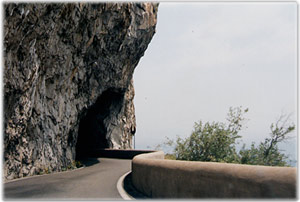 Heading east on Highway 163 |
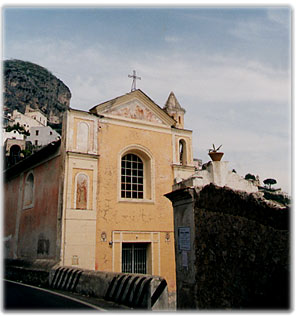 |
![]() We
travelled through Conca dei Marini, Amalfi
and Atrani, where we walked around town. Further east in Maori we
headed away from the Coast to the interior of the peninsula. Turning north
we went up into the hills. The road ran along the rim of a large valley,
full of terraced groves of lemon and olives trees and vineyards.(These
are no ordinary lemons, by the way, but mega-lemons. Larger than most
grapefruit.) It was very rural, peaceful and beautiful. The road was almost
empty, and we were compelled to stop for closer looks at nice vistas and
interesting characters.
We
travelled through Conca dei Marini, Amalfi
and Atrani, where we walked around town. Further east in Maori we
headed away from the Coast to the interior of the peninsula. Turning north
we went up into the hills. The road ran along the rim of a large valley,
full of terraced groves of lemon and olives trees and vineyards.(These
are no ordinary lemons, by the way, but mega-lemons. Larger than most
grapefruit.) It was very rural, peaceful and beautiful. The road was almost
empty, and we were compelled to stop for closer looks at nice vistas and
interesting characters.
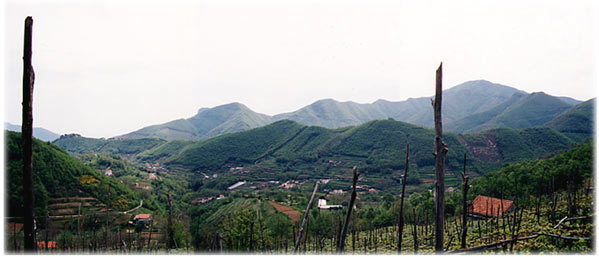
![]() After
making the turn at the top of the valley, we headed south again on the
other side. We came to Ravello, a town high above the Coast with an amazing
panoramic view. Besides the spectacular setting, Ravello is known for
its churches, villas, courtyards and gardens, and an annual event, the
Wagner festival, held in the tropical gardens of Villa Rufolo.
After
making the turn at the top of the valley, we headed south again on the
other side. We came to Ravello, a town high above the Coast with an amazing
panoramic view. Besides the spectacular setting, Ravello is known for
its churches, villas, courtyards and gardens, and an annual event, the
Wagner festival, held in the tropical gardens of Villa Rufolo.
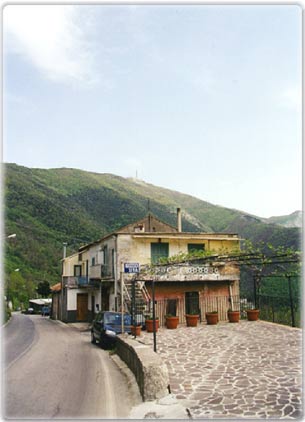 The
terrain in this area was so dramatic. There were deep, terraced valleys
running above and below road level, every inch of which was used for fruit
groves; while stalactites dripped from the mountain wall that ran along
the opposite side of the road.
The
terrain in this area was so dramatic. There were deep, terraced valleys
running above and below road level, every inch of which was used for fruit
groves; while stalactites dripped from the mountain wall that ran along
the opposite side of the road.
As we headed back to the hotel, we had to stop and look at one of the nicest ceramic shops we'd seen. The colorful pots, urns, plates, tables et al are an art form on the Coast; so far I'd resisted but this was our last day ...
So, at Ceramica Casola we had a nice conversation with Signore Casola who showed us his operation and explained how they created their wares. We found a table for our deck, put in an order, and looked forward to getting a large shipment a month or so out. And that was it, the exclamation point on our Coast experience.
We were at the halfway point of our trip. It was time to move on, to a very different part of Italy ...
Roma • Roma2 • Roma3 • Vesuvio & Pompei • Sorrento to Amalfi Coast • Capri
Amalfi Coast • Perugia • Siena & Toscana • Firenze • Firenze2
© 2001 CCarnovale Home | Web Design | Graphics | Photos | Travels